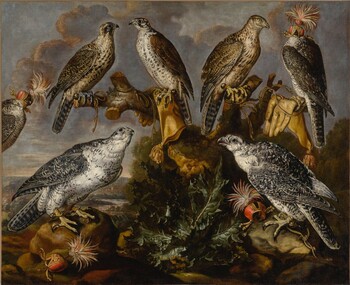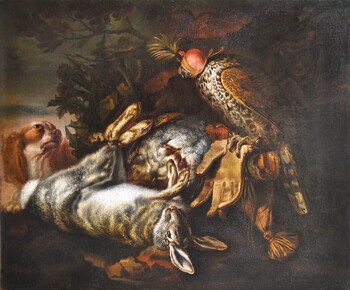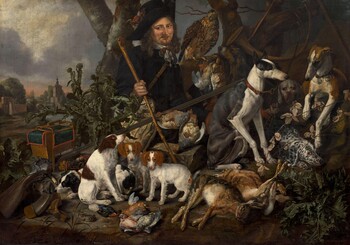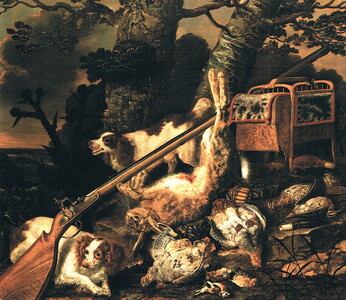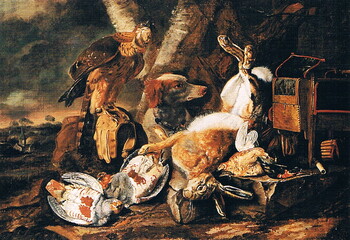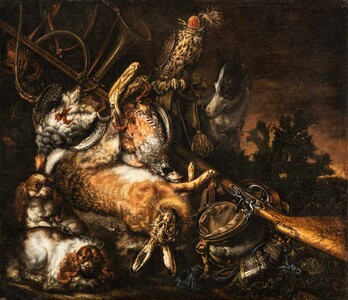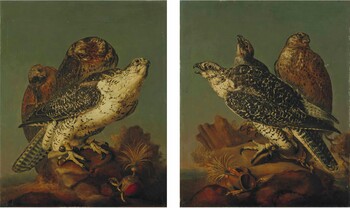31.500 €
Falcons and spaniels guarding the spoils of hunt
Oil on canvas : 110,4 X 150,2 cm
Unsigned
Frame : 134,4 X 174,9 cm
Provenance : Didier Aaron Gallery in Paris, with an erroneous attribution to Philip Ferdinand de Hamilton
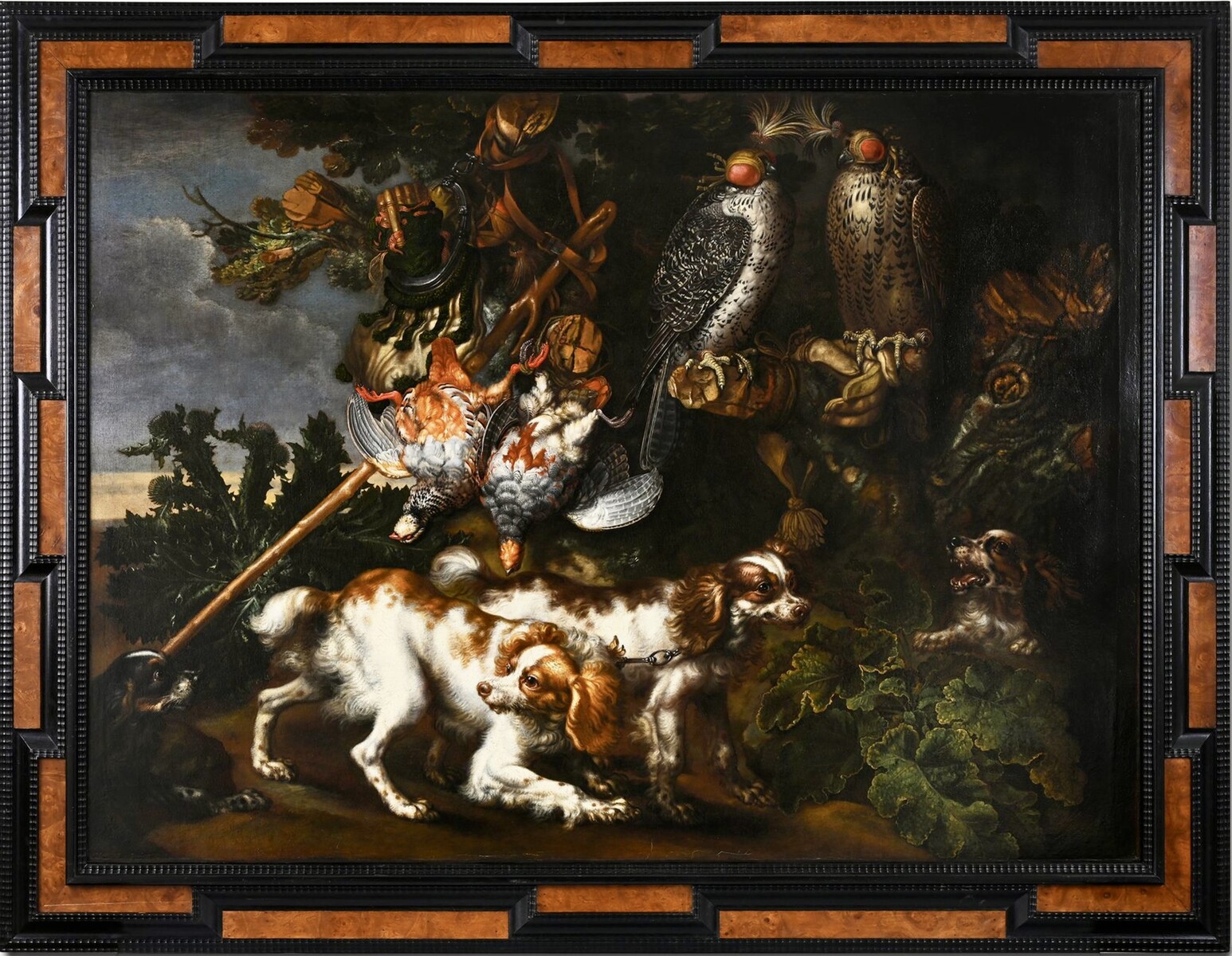
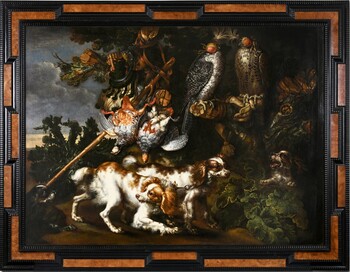
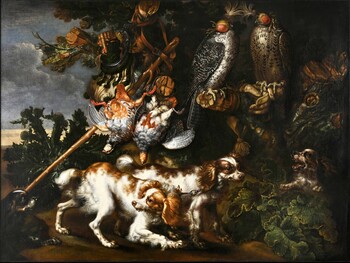
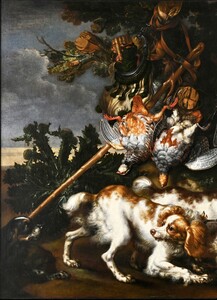
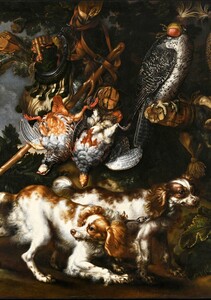
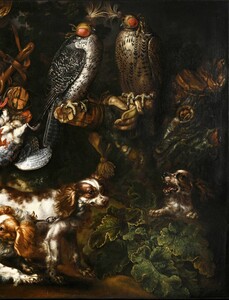
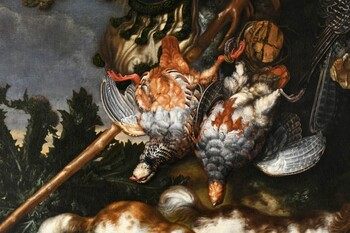
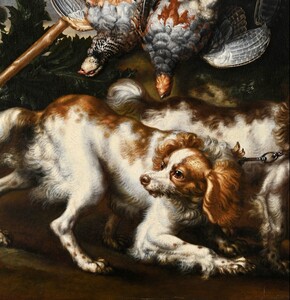
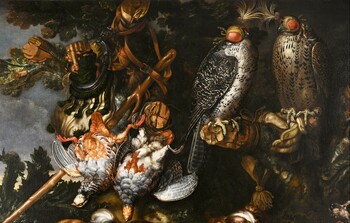
In short
Carstiaen Luyckx was a versatile and interesting Antwerp still life painter. Next to his traditional, high quality flower still lifes, garlands, Pronk and hunting still lifes he also painted very original subjects with Vanitas themes, forest floors and a few very nice bird scenes.
Luyckx’ hunting still lifes, which all date from rather late in his career, were strongly influenced by Jan Fyt.
Seventeenth century hunting scenes holding falcons are very sought after.
About Carstiaen Luyckx
Flemish painter
Antwerp 1623 – circa 1670 Antwerp
Still life painter.
His first name is sometimes spelt Carstian or even Christiaen.
Pupil in Antwerp of the still life painter Philip de Marlier in 1640 and from 1642 onwards of Frans Francken III. In his paintings neither one of them left their mark on his mature style. One does see the influence of Jan Davidsz. de Heem, of Daniel Seghers and of Jan Fyt (this last one on his hunting still lifes).
From 1645 onwards member of the Painter’s Guild of Saint Luke in Antwerp. In 1646 he is recorded as court painter to King Philip IV of Spain.
There are only two dated paintings known by Luyckx, both from 1650.
It is thought that Luyckx remained in Antwerp at least until the late 1650s: in 1652 he painted a mortuary crown for the deceased painter Victor Wolfvoet II, in 1653 his son (from his second marriage) was born here and he collaborated with David Teniers II and with Nicolaes van Verendael on a painting signed by all three, kept today in Dresden (Teniers and Verendael are documented in those years in Antwerp).
Subsequently Carstiaen Luyckx is thought to have left Antwerp, settling in France, probably in Northern France. Until now no traces of his stay there have been found. In 1644 he had already gone to Lille, but he had returned to Antwerp for his first marriage in 1645.
From 1649 onwards a fair number of his paintings turned out in the Dutch Republic, but there is no reason to think that at some stage he might also have moved northwards.
Luyckx was a versatile still life painter who painted Vanitas, hunting, flower and also a few fish and “pronk” still lifes.
His hunting still lifes, sometimes monogrammed “CL” or “KL”, were only fairly recently attributed to our painter. They are strongly influenced by the Flemish painter Jan Fyt. Some of them are actually still erroneously attributed to Jan Fyt, for example a painting in the Pushkin Museum in Moscow. Fred Meijer dates Luyckx’ hunting still lifes rather late in the artist’s oeuvre. In these years his style became more graphic.
About falconry during the 17th century
Hunting has always been a very prestigious pastime, limited in those days as much as possible to nobility. It was actually prohibited for the lower classes of society to hunt and poachers and other illegitimate hunters were severely prosecuted. Certain animals, such as falcons and marsh birds (herons) were protected by decree and the use of hunting dogs was reserved for the higher classes.
Basis for the noble sport of hunting was the following adagium: “fur against fur, plumes against plumes”. This meant that dogs would hunt for running animals such as deer, boars and hares, while birds would catch birds. In Flanders the Spanish Habsburg archdukes Albert and Isabella prohibited in a decree of 1613 the use of guns, nets and other mechanical devises to support this vision of the hunt. But a simple decree could of course not stop the popularity of fire arms, not even at their own court. The hunt for finches and ducks was also very popular in the Low Countries.
There were two types of falconry for hunting wildfowl :
- in the spectacular so-called high flight falcons dive onto their pray, in particular herons;
- in the so-called low flight hawks and sparrow hawks use a horizontal attacking technique.
Arendonk in Flanders and Valkenswaard in Holland were the main centres of falconry.
Peregrines were caught locally, the white gyrfalcons came from as far as Scandinavia and Iceland; they could cost more than a noble race horse. Both species were trained for hunting.
The hunting season ran from June 24th until November 11th.
Why should you buy this painting?
Because this very detailed, decorative hunting scene holds, next to the playful spaniels, two impressive falcons.
Comparative paintings
Click photos for more details

